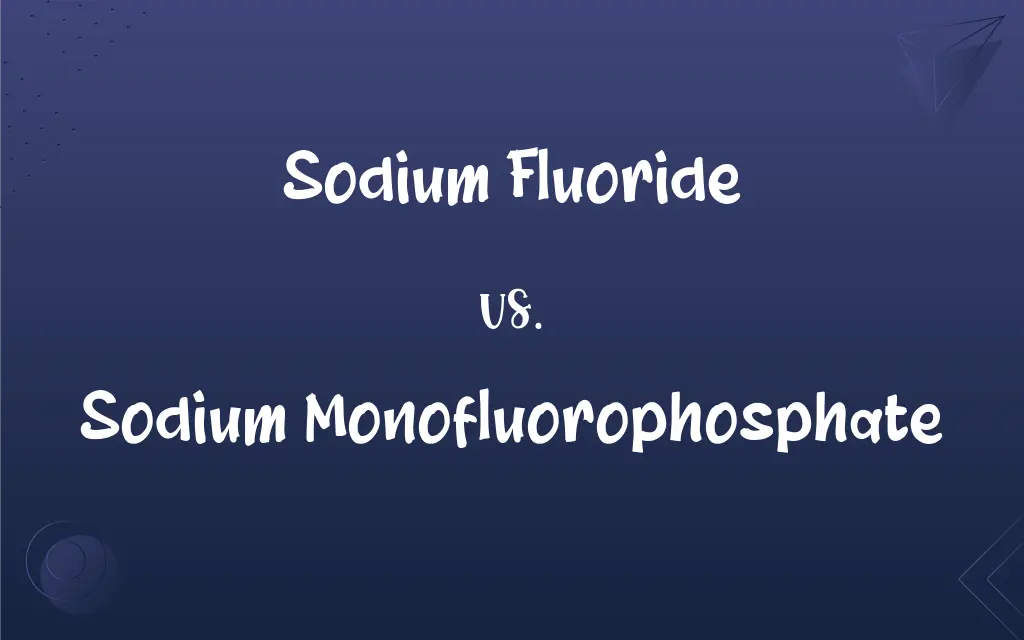Sodium Fluoride vs. Sodium Monofluorophosphate: What's the Difference?
By Aimie Carlson & Harlon Moss || Published on March 3, 2024
Sodium fluoride is a simple inorganic salt used in dental care for its anti-cavity properties, while sodium monofluorophosphate, also used in dental applications, offers similar benefits but with different chemical structures and applications.

Key Differences
Sodium fluoride (NaF) is a straightforward compound used primarily in toothpaste and water fluoridation to prevent dental cavities. It acts by strengthening tooth enamel and making it more resistant to acid attacks. Sodium monofluorophosphate (Na2PO3F), on the other hand, serves a similar purpose in dental health but is often chosen for its compatibility with other toothpaste ingredients and its less pronounced taste.
Both compounds are effective in remineralizing teeth and preventing demineralization, sodium fluoride is often recognized for its direct action and immediate availability as fluoride ions in dental products. Sodium monofluorophosphate, however, requires hydrolysis by enzymes in the saliva to release fluoride ions, which then contribute to dental health.
In terms of chemical composition, sodium fluoride is a simpler compound, making it easier to produce and incorporate into various formulations. Sodium monofluorophosphate, with its phosphate group, is a bit more complex and may offer additional benefits such as less abrasiveness in toothpaste formulations.
Safety profiles of both compounds are well-established, with sodium fluoride being used for decades in water fluoridation and dental products. Sodium monofluorophosphate is also recognized as safe and effective, but its usage is more confined to dental care products rather than broader applications like water fluoridation.
Despite their common use in oral hygiene products, the choice between sodium fluoride and sodium monofluorophosphate can depend on factors like formulation requirements, cost, and consumer preference, with each compound offering unique advantages in dental care applications.
ADVERTISEMENT
Comparison Chart
Chemical Formula
NaF
Na2PO3F
Primary Use
Dental caries prevention, water fluoridation
Primarily in toothpaste for dental caries prevention
Mechanism of Action
Directly provides fluoride ions
Requires hydrolysis to release fluoride ions
Compatibility
Broad, but can be reactive with some compounds
Generally good with various toothpaste ingredients
Taste
Slightly more pronounced
Milder, less noticeable
ADVERTISEMENT
Sodium Fluoride and Sodium Monofluorophosphate Definitions
Sodium Fluoride
Can be used in medical imaging.
Sodium fluoride PET scans detect bone changes.
Sodium Monofluorophosphate
Commonly found in toothpaste.
Many brands prefer sodium monofluorophosphate for its mild taste.
Sodium Fluoride
Available in various dental products.
Mouthwashes often contain sodium fluoride for extra protection.
Sodium Monofluorophosphate
Helps in remineralizing teeth.
It releases fluoride ions slowly, aiding enamel repair.
Sodium Fluoride
Subject to dosage guidelines.
Overuse of sodium fluoride products can lead to dental fluorosis.
Sodium Monofluorophosphate
Less abrasive on teeth.
Toothpaste with sodium monofluorophosphate is often recommended for sensitive teeth.
Sodium Fluoride
Sodium fluoride is used to prevent tooth decay.
It's often added to community water supplies.
Sodium Monofluorophosphate
Not used in water fluoridation.
Unlike sodium fluoride, it's not added to public water systems.
Sodium Fluoride
It strengthens tooth enamel.
Sodium fluoride in toothpaste helps harden enamel, reducing cavities.
Sodium Monofluorophosphate
Compatible with other ingredients.
Its stability allows for diverse toothpaste formulations.
FAQs
Why might a toothpaste brand choose sodium monofluorophosphate?
For its less pronounced taste and compatibility with other ingredients.
Can both compounds be found in toothpaste?
Yes, both are used in toothpaste formulations for their anti-cavity properties.
Is sodium fluoride safe for all ages?
Yes, when used appropriately, it is safe across different age groups.
What is sodium fluoride used for?
Sodium fluoride is used in dental care for cavity prevention and in water fluoridation.
Is sodium fluoride naturally occurring?
Fluoride ions occur naturally, but sodium fluoride as used in products is synthesized.
Is sodium monofluorophosphate effective in water fluoridation?
It's not typically used for water fluoridation, unlike sodium fluoride.
Do both compounds contribute to dental fluorosis?
Yes, but the risk is low when products are used as directed.
Can I find these compounds in all toothpastes?
Many, but not all, toothpastes contain one of these fluoride sources.
How do I know if my toothpaste contains these compounds?
Check the ingredient list on the toothpaste packaging.
How does sodium monofluorophosphate work?
It releases fluoride ions upon hydrolysis in the mouth, aiding in tooth remineralization.
Are these ingredients expensive?
They are relatively inexpensive, contributing to their widespread use in dental care.
Can I use products with these compounds daily?
Yes, products containing these are designed for daily use.
How do these compounds prevent cavities?
By strengthening tooth enamel and making it resistant to acid erosion.
Do these compounds have any environmental impact?
In proper disposal and usage, their environmental impact is minimal.
Is one more effective than the other?
Both are effective; the choice depends on the product formulation and personal preference.
Are there any side effects of using sodium fluoride?
Overuse can lead to dental fluorosis, but it's generally safe when used as directed.
Can sodium monofluorophosphate cause allergies?
Allergies are rare, but sensitivities to any compound, including this, can occur.
How long have these compounds been used in dental care?
Sodium fluoride has been used since the mid-20th century, and sodium monofluorophosphate has been used widely since the 1960s.
Are these compounds safe for pets?
Ingestion of toothpaste containing these compounds can be harmful to pets.
What happens if I swallow toothpaste with these compounds?
Small amounts are generally not harmful, but ingesting large amounts can be dangerous and should be avoided.
About Author
Written by
Aimie CarlsonAimie Carlson, holding a master's degree in English literature, is a fervent English language enthusiast. She lends her writing talents to Difference Wiki, a prominent website that specializes in comparisons, offering readers insightful analyses that both captivate and inform.
Co-written by
Harlon MossHarlon is a seasoned quality moderator and accomplished content writer for Difference Wiki. An alumnus of the prestigious University of California, he earned his degree in Computer Science. Leveraging his academic background, Harlon brings a meticulous and informed perspective to his work, ensuring content accuracy and excellence.







































































